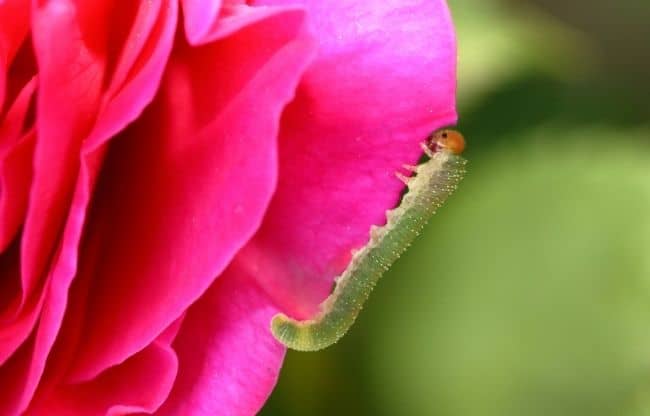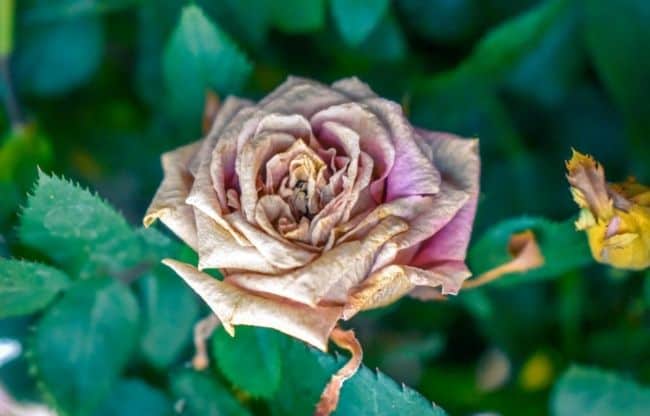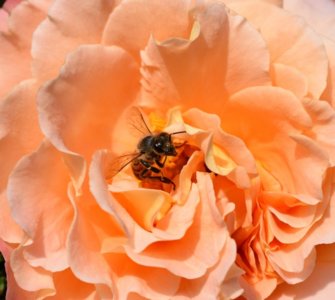Blueeeerghhhh I hate slugs full stop. Along with cockroaches, slugs are right up there in my list of creepy crawly no-nos. I just can’t do that rough and ready, embrace all creatures standard gardener thing. So when I found out about slugs that grow on my favourite flower I was revolted. What is a rose slug?!
Rose slugs are pests which attack roses in late spring and early summer. They harm roses by making distinctive holes in leaves, skeletonising them and browning them in the process. If untreated, they will eat and destroy your entire rose plant! Rose slugs can be tough to spot, as they are the same shade of green as your rose leaf. You can prevent rose slug infestations by learning how to identify them, manually removing them from the plant and using an insecticide organic soap. In late stages of the infestation, use a neem oil-based organic pesticide to remove all traces of rose slugs.
Table of Contents
How do I know if I have a rose slug infestation?
As I said earlier, during the summer season, it might be hard to tell precisely which pest or disease might be bothering your rose. Identifying if your pest is a rose slug helps you know how to get rid of them.
Identifying rose slugs might prove to be exceptionally tricky. Oftentimes, new gardeners complain that the leaves are becoming full of holes, but they can’t seem to find the bug anywhere. This is because a majority of rose slugs are pale green to leaf green, blending seamlessly with the foliage.
There are three distinctive species of rose slugs you might encounter.
Bristly rose slug
This critter is native to Europe and North America. It is usually pale green in colour, about 2 centimetres long and covered in tiny hair-like bristles. Bristly rose slugs are commonly found to prefer eating only the underside of the leaves. It is the only rose slug that reproduces more than once yearly. This means that if you notice an infestation during the summer – it is definitely this species of rose slugs!
European rose slug
European rose slugs are native to most of Europe. Their appearance is more like that of a snail, but they aren’t nearly as slimy. They are a bit smaller than bristly rose slugs, only about 1 centimetre in length. They prefer eating the upper side of the leaves.
Curled rose slug
By far, the most common and wide-spread species of rose slugs. They are a typical pastel green colour, easily over 2 centimetres long on average. Curled rose slugs get their name from their general affinity to curl up like snakes under the leaves they’re eating, which combined with their pastel green colour makes them really difficult to notice until it’s, occasionally, too late. They are also the ones responsible for eating through holes throughout the entire leaf, indiscriminately destroying rose plants.
Identifying Rose Slugs
You can tell if your plant has rose slugs by looking carefully at the damage on your rose plant. However sometimes even the damage can be confused for a rose disease instead of a rose pest infestation.
This is most often because, beside making holes in the leaves, certain species of rose slugs, as well as baby rose slugs, like to eat only one layer of leaves (upper or lower). This leaves the leaf looking diseased, with brown translucent spots looking like a fungal infection.
In bigger infestations, rose slugs eat leaves aggressively, skeletonising them. Skeletonisation happens when rose slugs eat upper of lower layers of leaves along the leaf veins, making the leaf appear like a brown, wispy and transparent shadow of its former self.
When do rose slugs attack roses?
Bristly rose slugs multiply multiple times during the year, so you might see damage on your leaves during late spring, repeating in early summer and then late summer.
Other species of rose slugs will only attack in late spring to early summer, May and June being the most likely months during which you will be able to see an infestation.
Are rose slugs dangerous to roses, humans or pets?
Rose slugs are harmless to humans and pets. While they are wasps, they’re not poisonous, they don’t bite or attack humans or pets. Your pets might dislike them, as they tend to be a bit smelly.
However, if left unchecked, especially during a bigger infestation, they can eat up your roses. This is why it is important to be able to know what is a rose slug and how to get rid of them before it’s too late.
By the way, don’t worry, you didn’t choose the wrong variety of a rose to plant. Your rose supplier didn’t cheat you either, telling you that the rose is pest-resistant and now its overrun by rose slugs. Simply, rose slugs are one of the pests that will attack even the hardiest of roses.
How to Organically Get Rid Of Rose Slugs
While rose slugs might be particularly annoying to identify, they are exceptionally easy to combat organically.
Use Neem Oil
Neem oil is a great, organic solution for getting rid of rose slugs.
Opt for 100% pure cold-pressed neem oil for best results. Neem oil is a natural insecticide, pesticide and fungicide.
The main active ingredient in neem oil is azadirachtin, which can be found in the seeds of the neem tree. Azadirachtin reduces the feeding time of rose slugs, starving them slowly over time. At the same time, it works to interfere with insects’ hormones, disabling them from growing and laying eggs around your rose. It is a repellant, discouraging any incoming rose slugs.
Other active ingredients in neem oil are nimbin, picrin and sialin – all working overtime as repellants and inhibitors for over 200 different species of pests.
You can supplement neem oil with neem oil extract, which is generally richer in nimbin, picrin and sialin and poorer on azadirachtin. Together, they cook up a perfect organic pesticide storm for rose slugs!
Organic Rose Slug Repellent Recipe!
You will need
- 10 mL neem oil
- 10 mL neem oil extract
- 1 L of water
- 1-2 teaspoons of emulsifier of choice, but we recommend:
- Dawn organic dish soap
- hemp peppermint pure castile soap
- any organic insecticidal soap that doesn’t bubble up too much
The process
- Mix neem oil, neem oil extract and emulsifier of choice in a glass.
- Add the combined mixture to 1 liter of water into a spray bottle.
- Mix and shake well.
Alternatively, you can crush up 3 cups of neem leaf and 6 cloves of garlic and combine with 1 litre of water. Keep overnight, mix well the following day and strain through cheesecloth. Transfer to a spray bottle and you’re ready to battle!
Applying Slug Repellent
Patch-test a single rose leaf first to see if your rose has an adverse reaction. If it seems good after a day or two, carry on with using it on the entire plant.
Spray your solution liberally. Apply the pesticide early in the morning, so that foliage has time to dry.
Avoid application during the evening, in order to not invoke leaf rot. Avoid application during the hot afternoons, to avoid your roses being burned and hurt by the sunshine.
Spray your rose plants from the top, covering buds and upper sides of the leaves. Try to get as much solution as possible onto the rose – really drench it.
After spraying the upper side, lift the underside and give it a heavy dousing as well. Spray any rose slugs that you spot so that the neem oil can work as a contact pesticide.
After coating the leaves, go in and spray the lateral and main canes of your rose bush. Spray thoroughly onto the base of the rose and surrounding soil to keep rose slugs from climbing back up the stems.
Avoid spraying open blooms.
Repeat this process every 3-4 days for heavy infestations. Otherwise, spray fully and repeat after 14 days have passed. Reapply in case of heavy rains. Discontinue use when you see a noticeable improvement.
Tips to prevent rose slug infestation
- Use a pressure water stream to keep away a small infestation. Or, if you don’t mind slugs, manually pick them off and eliminate.
- Spray the rose with an insecticide organic soap. Mix a few teaspoons of soap with a liter of water, spray the rose and let dry.
- Sprinkle diatomaceous earth on the soil and around the base of the rose to prevent larvae climbing up the stems.
- Prune your rose. Diligent pruning of diseased wood prevents rose slugs being attracted to the rose.
Phew! That’s the end of the line for the rose slug – and how to get rid of them is actually easy! If you think you might have aphid problems, instead of rose slugs – read up on how to get rid of aphids, fast and simple!




